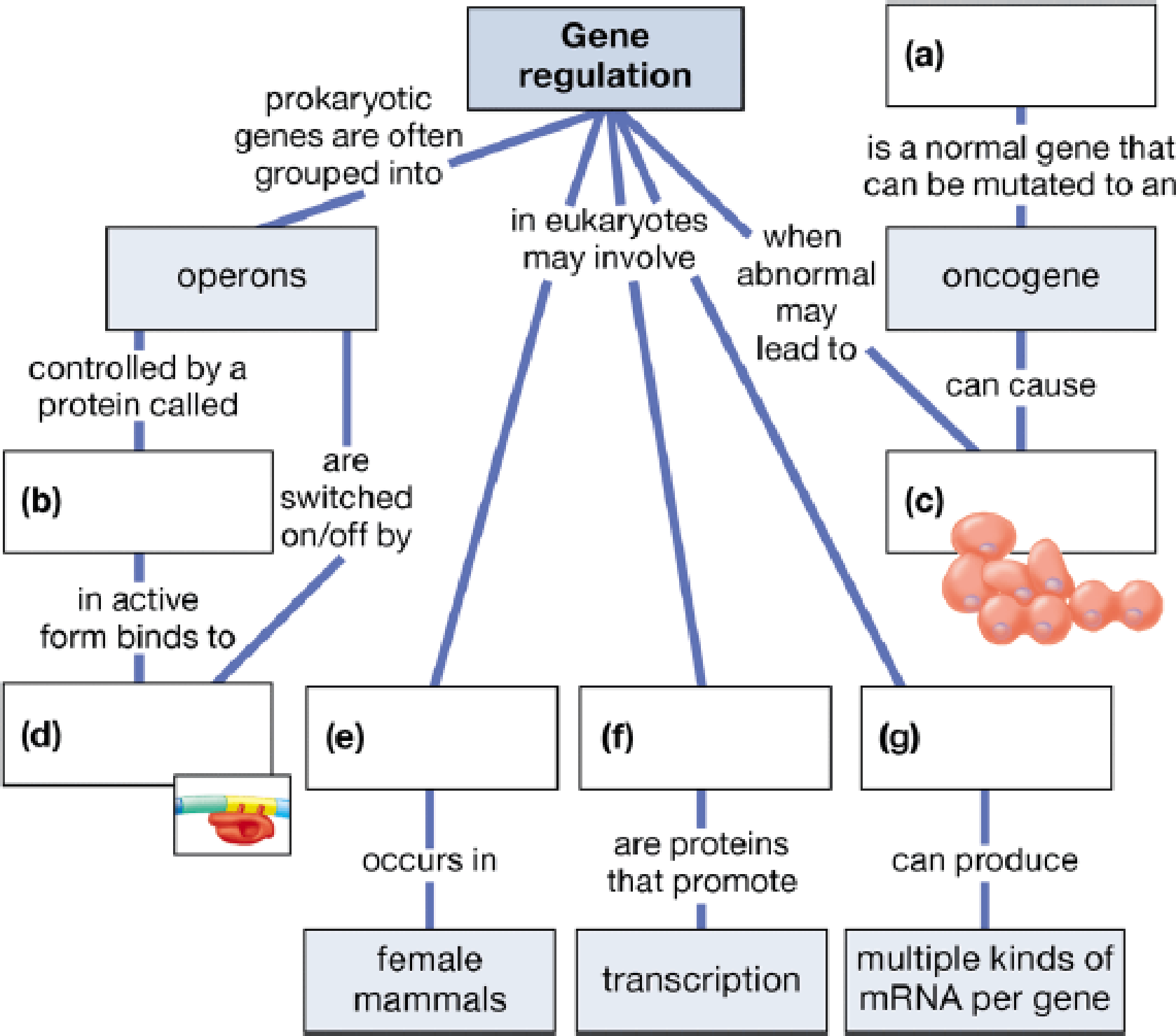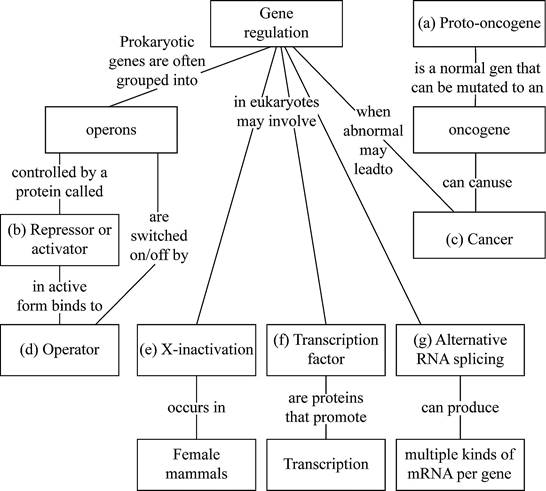
Concept explainers
Complete the following concept map to test your knowledge of gene regulation.

To complete: The given map showing a process of gene regulation.
Introduction: Gene regulation is a process where the expression of genes are controlled for the synthesis of specified gene products (usually RNA or proteins).
Answer to Problem 1CC
Pictorial representation: Figure 1 shows the completed map of the gene regulation in prokaryotes and eukaryotes.

Fig. 1: Gene regulation in prokaryotes and eukaryotes
Explanation of Solution
(a)
Correct answer: Proto-oncogenes.
Explanation: Proto-oncogenes are the common genes which are transformed into oncogenes (malignant genes) during mutation. These mutations can lead to indefinite proliferation of cells.
(b)
Correct answer: Repressor or activator.
Explanation: They are the molecules which regulates the transcription. Activators are transcription factors that activate or boost a gene to express and the repressors are the molecules that stop the expression of a gene.
(c)
Correct answer: Cancer.
Explanation: Cancer is a diseased condition where the normal cells get converted to abnormal cells through undifferentiated and uncontrolled growth.
(d)
Correct answer: Operator.
Explanation: Operator is a part of the operons which regulates the binding of a repressor molecule to it. The transcription is stopped when the repressor binds to the operator, thereby it blocks the further binding of RNA polymerase to initiate the transcription.
(e)
Correct answer: X-inactivation.
Explanation: The process of inactivation of single copy of X chromosomes in female mammals is called as X-inactivation.
(f)
Correct answer: Transcription factors.
Explanation: The proteins that are associated with the transcription of DNA to mRNA are called as transcription.
(g)
Correct answer: Alternative RNA splicing.
Explanation: Alternative splicing (differential splicing) is the process of regulation during a gene expression to produce a single gene which can code for different proteins. Final product of alternative splicing will be a processed mRNA.
Want to see more full solutions like this?
Chapter 11 Solutions
CAMPBEL BIOLOGY:CONCEPTS & CONNECTIONS
- Put the following processes in order of their occurrence during expression of a eukaryotic gene: a. mRNA processing c. transcription b. translation d. RNA leaves nucleusarrow_forwardPlease help me with part one question 3 Thank you PDF link https://www.cusd80.com/cms/lib/AZ01001175/Centricity/Domain/8922/eofad.pdfarrow_forwardThe figure below represents a cell undergoing gene expression. Use the figure to answer the questions that follow (a - e). a. What is indicated by label (2) in the figure above? b. What is indicated by label (3) in the figure above? c. What happens to the part labelled (3) and what complex makes it happen? d. Which amino acid is represented by (6)? e. Give the one anticodon in the 5' to 3' direction that will recognize all the codons for this amino acid in (c)arrow_forward
- A KDEL sequence is a sequence of amino acids in a protein that binds a KDEL receptor, which helps recycle it back to the ER. Name two techniques a scientist could use in combination to experimentally demonstrate the function of a KDEL sequence. (To help you think about how to answer this: What would happen if the KDEL sequence were nonfunctional? How could you observe the result?) Please answer this and thank you!arrow_forwardYou are studying the M-cyclin. You treat mitotic cells with an inhibitor of the proteasome and find that M-cyclin is no longer degraded and that this prolongs mitosis. You also find that in the presence of the inhibitor, M-cyclin is now running slower/larger in a Western than you have previously observed. In 1-2 sentences, explain why this might be happening. Edit View Insert Format Tools Table 12pt Paragraph B IU Αν S A C I AT²✓ #tv A MacBook Air X : Garrow_forwardYou hope to study a gene that codes for a neurotransmitter protein produced in human brain cells. You know the amino acid sequence of the protein. Explain how you might (a) identify what genes are expressed in a specific type of brain cell, (b) identify (and isolate) the neurotransmitter gene, (c) produce multiple copies of the gene for study, and (d) produce large quantities of the neurotransmitter for evaluation as a potential medication.arrow_forward
- Suppose that you are carrying out studies of microtubule assembly via in vitro (in the test tube – not in the cell) assays. In a mixture of α-tubulin, β-tubulin, and abundant GTP, all suspended in a buffer that approximates cellular pH, you discover that you need the tubulin concentration to be at least 15 µM in order to observe any microtubule assembly. However, if you add centrosomes (including the proteins of the pericentriolar region) to your mixtures, you are able to observe microtubule assembly at concentrations of tubulin as low as 2 µM. At which end(s) of the microtubule would you expect addition of tubulin monomers to be occurring in your mixtures that include centrosomes?arrow_forwardThe diagram below shows the structure of DNA from the level of a gene to a condensed mitotic chromosome. At each of the four locations marked, indicate how a gene may be regulated by selecting from the choices given. Some answer choices may fit into more than one position; however, you should use each answer choice only once. Choices given: Alternative splicing within the gene sequence can lead to different forms of mRNA. A promoter region can be blocked by another protein. Histone deacetylation can prevent DNA from unwinding. A regulatory region can be bound and increase transcription rates.arrow_forwardSuppose that you are carrying out studies of microtubule assembly via in vitro (in the test tube – not in the cell) assays. In a mixture of α-tubulin, β-tubulin, and abundant GTP, all suspended in a buffer that approximates cellular pH, you discover that you need the tubulin concentration to be at least 15 µM in order to observe any microtubule assembly. However, if you add centrosomes (including the proteins of the pericentriolar region) to your mixtures, you are able to observe microtubule assembly at concentrations of tubulin as low as 2 µM. Why does the addition of centrosomes to your mixture make such a difference in the concentration of tubulin needed to achieve assembly? At which end(s) of the microtubule would you expect addition of tubulin monomers to be occurring in your mixtures that include centrosomes? Suppose that you further altered your solution by replacing GTP with a GTP analogue that behaves like GTP in all respects, other than its ability to be hydrolyzed to…arrow_forward
- A gene in a eukaryotic cell is not being expressed but there is no mutation in its DNA sequence. In your own words using complete sentences give a plausible explanation as to why the gene is not being expressed using one of the concepts discussed in class. You must fully explain what is happening to cause the gene not to be expressed. You will be graded on grammar, content and thoroughness of your answer.arrow_forwardCreate a Venn diagram to compare and contrast the process of gene expression in Bacteria versus eukaryotes. Remember that “gene expression” can include any part of transcription or translation. Try to be as thorough as you can about what aspects of this process are similar between the two taxa, and what characteristics are distinct to only Bacteria or eukaryotes. Plase include a minimum of 15 items in the Venn diagram.arrow_forwardThe diagram shown represents the coding strand of the myosin gene. Mutations in myosin can lead to muscle defects during development. Using what you know about how mutations can affect transcriptional and post-transcriptional regulation, match the results shown on the Northern (mature mRNA) to the mutations shown. The N lane shows the size and amount expected for non-mutated myosin mRNA. All samples were loaded at the top (-) side of the gel. Part 1. Which lane or lanes on the gel could be the result of mutation A? --4 ТАТАА AUG UAA Only known regulatory region TSS Mutation B: Mutation C. A: 5-base 20 nucleotides 3 nucleotides deletion deleted changed N 1 2 3 4 5arrow_forward

 Human Heredity: Principles and Issues (MindTap Co...BiologyISBN:9781305251052Author:Michael CummingsPublisher:Cengage Learning
Human Heredity: Principles and Issues (MindTap Co...BiologyISBN:9781305251052Author:Michael CummingsPublisher:Cengage Learning

